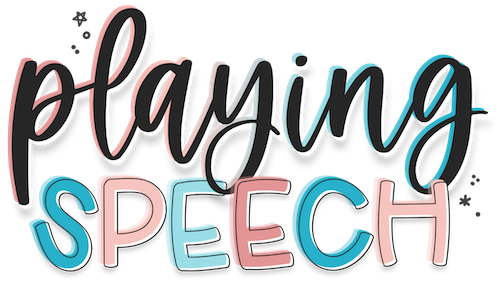The Building Blocks of Communication: The Importance of Syntax in Preschool Speech Therapy
Syntax, Speech Therapy, and Preschoolers
When working with preschoolers in speech therapy, we often work a LOT on vocabulary expansion. But we have to consider that we also need to target syntax! Syntax simply defined is the arrangement of words to create sentences.
This need to explicitly target syntax in our preschool speech therapy sessions comes from the knowledge that increasing a child’s ability to deconstruct, understand, and eventually utilize simple and complex syntactical structures plays a pivotal role in a child's overall language development and later, literacy skills! We also know that many children with language delays have impaired ability to understand and use more complex syntactical structures. Meaning we should definitely be targeting syntax with this population!
We also know that syntax interventions have significant impact on children with language delays. Improved syntax skills leads to enhanced communication proficiency. Interventions targeting syntax not only improve receptive language but also expressive language skills.
And, The Informed SLP tells us that “morphology/syntax interventions have a stronger evidence base than most other language therapy protocols, and the research demonstrates that explicit instruction is better than exposure alone.”
In the preschool setting, speech therapists play a crucial role in laying the groundwork for syntax development. Working on basic syntax structures in preschool is like planting the seeds for future linguistic success. It lays the groundwork to later focus on more complex syntactical structures.
Ways to Work on Syntax in Preschool Speech Therapy
There are many ways to work on syntax skills in preschool speech therapy. Firstly, you will have to identify where the breakdown occurs. Is this child having trouble with early morphological markers like past tense -ed or plual -s? Or is the issue with more complex syntactical structures like understanding compound sentences? This will help you determine your starting point in therapy.
Syntax is a complicated area, and I highly recommend The Informed SLP’s Grammar Guide found HERE to see all the different areas of grammar and syntax we can target and a general scope and sequence!
But, here are some general ways to work on syntax in preschool speech therapy:
model the grammatical structure you want the child to learn
recast incorrect productions by the child
expand on the child’s utterances with more complex grammatical structures
have the child imitate (in mass practice) the grammatical structure you are targeting
That last point was the inspiration behind my latest resource found HERE where children unscramble simple sentences. There are multiple exemplars of the same sentence stem so the child really gets to practice the sentence structure!
Preschool Syntax Summed Up
The need to target syntax in preschool speech therapy is rooted in a deep understanding of its pivotal role in shaping a child's linguistic and literacy skills. By specifically targeting syntax skills early on, speech therapists can affect a child's ability to understand and communicate effectively and improve reading comprehension. There are many grammatical skills that a speech therapist can target, but knowing some general intervention techniques can help make your syntax intervention effective!
SOURCES:
Finestack, L. H. (2018). Evaluation of an explicit intervention to teach novel grammatical forms to children with developmental language disorder. Journal of Speech, Language, and Hearing Research. Advance online publication. https://doi.org/10.1044/2018_JSLHR-L-17-0339
Finestack, L. H., Ancel, E., Lee, H., Kuchler, K., & Kornelis, M. (2023). Five additional evidence-based principles to facilitate grammar development for children with developmental language disorder. American Journal of Speech-Language Pathology. https://doi.org/10.1044/2023_ajslp-23-00049
Ebbels, S., & Owen Van Horne, A. (2020). Grammatical concepts of English: Suggested order of intervention. The Informed SLP. https://www.theinformedslp.com/review/the-grammar-guide-you-never-knew-you-always-wanted
Gillon, G., & Dodd, B. (1995). The effects of training phonological, semantic, and syntactic processing skills in spoken language on reading ability. Language, Speech, and Hearing Services in Schools, 26(1), 58–68. https://doi.org/10.1044/0161-1461.2601.58


